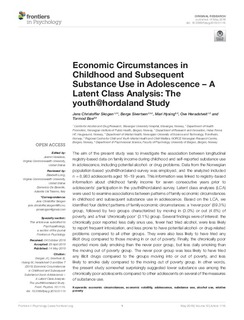| dc.contributor.author | Skogen, Jens Christoffer | |
| dc.contributor.author | Sivertsen, Børge | |
| dc.contributor.author | Hysing, Mari | |
| dc.contributor.author | Heradstveit, Ove | |
| dc.contributor.author | Bøe, Tormod | |
| dc.date.accessioned | 2019-06-21T07:36:07Z | |
| dc.date.available | 2019-06-21T07:36:07Z | |
| dc.date.created | 2019-06-20T15:05:16Z | |
| dc.date.issued | 2019 | |
| dc.identifier.citation | Frontiers in Psychology. 2019, 10 . | nb_NO |
| dc.identifier.issn | 1664-1078 | |
| dc.identifier.uri | http://hdl.handle.net/11250/2601626 | |
| dc.description.abstract | The aim of the present study was to investigate the association between longitudinal registry-based data on family income during childhood and self-reported substance use in adolescence, including potential alcohol- or drug problems. Data from the Norwegian population-based youth@hordaland-survey was employed, and the analyzed included n = 8,983 adolescents aged 16–19 years. This information was linked to registry-based information about childhood family income for seven consecutive years prior to adolescents’ participation in the youth@hordaland-survey. Latent class analyses (LCA) were used to examine associations between patterns of family economic circumstances in childhood and subsequent substance use in adolescence. Based on the LCA, we identified four distinct patterns of family economic circumstances: a ‘never poor’ (89.3%) group, followed by two groups characterized by moving in (3.0%) or out (4.6%) of poverty, and a final ‘chronically poor’ (3.1%) group. Several findings were of interest: the chronically poor reported less daily snus use, fewer had tried alcohol, were less likely to report frequent intoxication, and less prone to have potential alcohol- or drug-related problems compared to all other groups. They were also less likely to have tried any illicit drug compared to those moving in or out of poverty. Finally, the chronically poor reported more daily smoking than the never poor group, but less daily smoking than the moving out of poverty group. The never poor group was less likely to have tried any illicit drugs compared to the groups moving into or out of poverty, and less likely to smoke daily compared to the moving out of poverty group. In other words, the present study somewhat surprisingly suggested lower substance use among the chronically poor adolescents compared to other adolescents on several of the measures of substance use. | nb_NO |
| dc.language.iso | eng | nb_NO |
| dc.publisher | Frontiers Media | nb_NO |
| dc.rights | Navngivelse 4.0 Internasjonal | * |
| dc.rights.uri | http://creativecommons.org/licenses/by/4.0/deed.no | * |
| dc.title | Economic Circumstances in Childhood and Subsequent Substance Use in Adolescence – A Latent Class Analysis: The youth@hordaland Study | nb_NO |
| dc.type | Journal article | nb_NO |
| dc.type | Peer reviewed | nb_NO |
| dc.description.version | publishedVersion | nb_NO |
| dc.source.pagenumber | 10 | nb_NO |
| dc.source.volume | 10 | nb_NO |
| dc.source.journal | Frontiers in Psychology | nb_NO |
| dc.identifier.doi | 10.3389/fpsyg.2019.01115 | |
| dc.identifier.cristin | 1706519 | |
| dc.description.localcode | Copyright © 2019 Skogen, Sivertsen, Hysing, Heradstveit and Bøe. This is an open-access article distributed under the terms of the Creative Commons Attribution License (CC BY). The use, distribution or reproduction in other forums is permitted, provided the original author(s) and the copyright owner(s) are credited and that the original publication in this journal is cited, in accordance with accepted academic practice. No use, distribution or reproduction is permitted which does not comply with these terms. | nb_NO |
| cristin.unitcode | 194,65,35,0 | |
| cristin.unitname | Institutt for psykisk helse | |
| cristin.ispublished | true | |
| cristin.fulltext | original | |
| cristin.qualitycode | 2 | |

